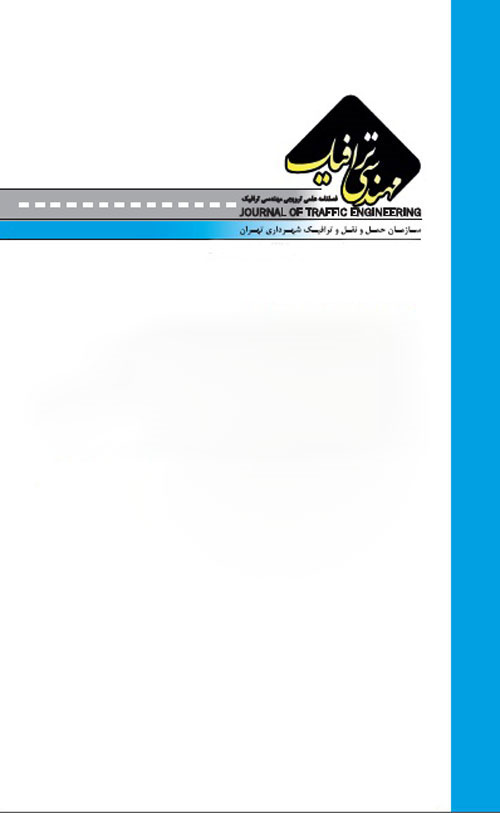فهرست مطالب

نشریه مهندسی ترافیک
پیاپی 59 (زمستان 1393)
- تاریخ انتشار: 1393/12/20
- تعداد عناوین: 7
-
-
Page 5Transportation has inevitable effects on human, s lives. This study was analyzed the relation between transportation improvement indicators and ecological footprint by quantitative and statistical methods. The main question of the study is that «increasing the development indexes and improving transportation have any influence on the improvement of the transportation footprint in the country. So, nine indexes were selected as variables of transportation improvement. Data of indexes were obtained from the annual statistics of provinces and road organization. Results show an inverse correlation between the indexes of density of the main roads and highways and positive correlation between density of the highways and average traveled kilometers per trip.Keywords: Region Stability, Regional Development, Ecological Footprint, Consumption per Capita
-
Page 16Optimization of Airports, gate scheduling is a vital activity. The main purpose of this optimization is to find a proper allocation for the flights arriving and departing by considering all of limitations. Studies show that the gate scheduling is applied for minimizing the gate flights delay and maximizing the gate efficiency and productivity. The optimization is formulated as a mixed-integer programming (MIP). The paper is studied data from Mehrabad International Airport. Our results show that the model can be solved by using NSGA-II algorithm in a short time. The set of Pareto solutions are ranked by TOPSIS method and the first 10 solutions are reported. The results show that although adding the first objective function (crowd congestion) leads to %8 reduction of the third objective function (the total gate assignment preference); the first objective function has a positive effect on the satisfaction of passengers.Keywords: Air Transportation, Gate scheduling, Mixed Integer Programming, NSGA-II
-
Page 24One of the main reasons of using vehicles by human is reduction of travel time. Although increasing the speed of can decrease travel time, it has a significant impact on increasing the probability of accidents and severity of them. Therefore, relationship between social costs and speed can be applied for speed management of traffic network. The purpose of this research is to determine the social costs of accidents and travel time based on different speeds for increasing safety of traffic network. The case study is Shiraz-Marvdasht highway in Fars province. Mean travel time at different speed limits are estimated by AIMSUN (traffic simulation software). Results show that increasing the cost of travel time in traffic flow having a lower average speed. The results of the study show that the optimal speed would be 72 km/h due to the total travel time and the number of accidents.Keywords: Social, Accident Costs, Optimization of Speed, Cost of Travel Time
-
Page 34This study was conducted to determine the attitude and the operation of pedestrians and factors affecting pedestrians non-compliance traffic behavior in Mashhad. The data was collected from the population included all pedestrians passing in the street of Mashhad. Stratified, systematic and random sampling strategy was used to select respondents and 240 persons were determined for the study. Results showed that 63.3 percent of persons had negative attitude, 72.9 percent of pedestrians declared that they usually observe traffic rules while crossing the streets but 27.1 percent of pedestrians disobeyed traffic rules. The Mann-Whitney U test proved that there are significant differences between men and women non-compliance traffic behavior. Kruskal-Wallis H test did not show any difference between education and pedestrians non-compliance traffic behavior. At the end paper showed that social trust, control and deprivation didnt have significant relation with non-compliance traffic pedestrians.Keywords: Non- Compliance Traffic Behavior, Pedestrians, Mashhad
-
Page 46Headway distribution of vehicles in the traffic stream is considered as a crucial
factor. In this study some statistical models are fitted on measured time headway.
Traffic data were gathered from Tehran-Qom freeway in two different months, in
April as a high traffic flow and in January as a low traffic flow. In this study simple and
combined models were fitted on field measured data. The goodness of fitness were
evaluated after calibrating the statistical models parameters. Results showed that the
distribution of headways can be predicted by proposed statistical models.Keywords: Statistical model, Headway, Effect of social behavior, Effect of night, day -
Page 56The performance of a traffic network can be influenced by several types of actions or decision variables. Some of variables want to change the load pattern on the network, others want to control traffic flow through the network components, such as junction utilization through signal control. Traffic prediction has a fundamental effect on traffic control. Due to the fact that neural networks are reliable tools in cognition of traffic patterns and according to the capability of genetic algorithm in searching and finding the best solution among probable solutions, in this paper the combination of neural networks and genetic algorithm is applied in order to adjust signal timing in adjacent intersections. The performance index in this paper is network average delay. The results show that the obtained optimum timing reduces the network average delay in compared with timing obtained from SYNCHRO optimization software.Keywords: Signal Timing, Genetic Algorithm, Neural Network, Series Intersection
-
Page 64Sixty percent of motorcyclist fatalities in traffic accidents of Iran are due to head injuries, but helmet-use is low, despite it being a legal requirement. This study used face-to-face interviews to investigate the factors associated with helmet-use among motorcycle riders in Mashhad city, the second largest city in Iran. PCA and CFA were used for data reduction and identification of consistent features of the data. Ordered and multinomial logit analysis were applied to quantify the influences on helmet user. According to the statements of motorcyclist,s rate of helmet-use is 47 percent, but in 14 percent of cases helmets were not used properly. In addition, 5 percent of motorcyclists believed in malicious impact of helmets on their safety. Duration of daily trips with motorcycle, riding experience and type of job were affecting helmet-use behavior.Keywords: Motorcyclist, Helmet-use, Enforcement, Factor analysis, Logit

